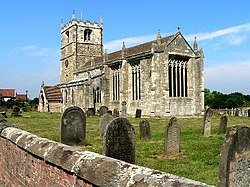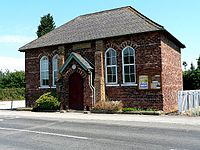Skipwith
| Skipwith | |
| Yorkshire East Riding | |
|---|---|
 St Helen's parish church | |
| Location | |
| Grid reference: | SE6638 |
| Location: | 53°50’19"N, 0°59’48"W |
| Data | |
| Population: | 266 (2011) |
| Post town: | Selby |
| Postcode: | YO8 |
| Dialling code: | 01757 |
| Local Government | |
| Council: | North Yorkshire |
| Parliamentary constituency: |
Selby |
| Website: | Skipwith |
Skipwith is a village in the East Riding of Yorkshire, about four miles north-east of Selby and ten miles south-east of York.
The village has a public house, the Drovers Arms, which is now a gastropub.[1]
Contents
History
The Domesday Book records that by 1086 Robert de Stutville held a carucate of land at Skipwith.[2] His family held a manor here until 1229, when it passed to Hugh Wake by his marriage to Joan de Stutville.[2] In 1325 it passed to Edmund of Woodstock, 1st Earl of Kent by his marriage to Margaret Wake, 3rd Baroness Wake of Liddell.[2] It remained with his heirs until 1418,[2] a decade after their line became extinct with the death of Edmund Holland, 4th Earl of Kent in 1408.[2]
Churches
Church of England
The oldest parts of the parish church of St Helen are Anglo-Saxon. The west tower began as a porch, but in the 11th century upper stages were added to turn it into a tower.[3] The tower is linked with the nave by a characteristic Saxon plain Romanesque round arch,[3] so the nave must also have originally been Saxon.
A Norman north aisle of two bays was added to the nave in about 1190, linked with the nave by an arcade of pointed arches.[3] This was followed by the south aisle, whose arcade has octagonal columns.[3] The nave and aisles were then extended eastwards with the addition of a third bay.[3]
The present chancel was built about 1300.[4] It is lofty and has large, square-headed windows with Decorated Gothic tracery.[4] The chancel windows were glazed with mediæval stained glass, fragments of which survive.[3]
In the 15th century the tower was raised again with the addition of a new bell-stage above the 11th-century Saxon one.[3] In the 16th century, possibly after the Reformation, a clerestory was added to the nave and new square-headed windows were inserted in the north aisle.[3]
In 1821–22 the Gothic Revival south porch was added,[5] and in 1877 the church was carefully restored under the direction of John Loughborough Pearson.[3] Notably, the south door was replaced but re-using its original 13th-century ironwork.[3] St Helen's is a Grade I listed building.[5]
Methodist
Two families in Skipwith were Methodists by 1764.[2] The village's Methodists worshipped in each other's homes until 1833, when a Wesleyan Methodist chapel was built.[2] In the 1860s the Vicar of St Helen's claimed that 300 or 400 of the villagers were Methodists.[2] In 1876 the first chapel was replaced with a larger brick one next to the parish school.[2]
The chapel is now Skipwith Methodist Church.[2] It is a member of the Goole and Selby Methodist Circuit.[6]
About the village
Skipwith Hall is early in the 18th century house of seven bays and two and a half storeys,[3] flanked by a three-bay wing on each side.[7] It is now a Grade II* listed building.[8]
A school and schoolmaster's house built in 1714,[7] founded and endowed by the bequest of a Dorothy Wilson.[2][9] In the 1851 its pupils included eleven boarders], and in the 1860s a separate classroom for girls was added.[2] In 1871 the school had 54 pupils but in 1872 this fell to only 30.[2] From the 1900s to the 1930s the school averaged 30–40 pupils, but in 1938 this had declined to 26.[2] In 1957 the school was closed and its pupils were transferred to Thorganby.[2] Since 1959 the school has served as the village hall.[2]
Half a mile south-west of the village is the site of RAF Riccall, a training airfield that was a heavy bomber conversion unit in the Second World War. The site is now a national nature reserve known as Skipwith Common.[10]
Outside links
| ("Wikimedia Commons" has material about Skipwith) |
References
- ↑ "Drovers Arms at Skipwith". http://www.thedroversarmsskipwith.com/.
- ↑ 2.00 2.01 2.02 2.03 2.04 2.05 2.06 2.07 2.08 2.09 2.10 2.11 2.12 2.13 2.14 2.15 Allison 1976, pp. 89–101
- ↑ 3.00 3.01 3.02 3.03 3.04 3.05 3.06 3.07 3.08 3.09 3.10 Pevsner 1972, p. 341
- ↑ 4.0 4.1 Pevsner 1972, p. 340
- ↑ 5.0 5.1 National Heritage List 1148467: Church of Saint Helen (Grade I listing)
- ↑ "Skipwith Methodist Church.". Churches. Goole and Selby Circuit. 2013. http://www.gooleselbymethodist.org.uk/churches.php?id=113.
- ↑ 7.0 7.1 Pevsner 1972, p. 342
- ↑ National Heritage List 1172750: Skipwith Hall (Grade II* listing)
- ↑ National Heritage List 1148468: Village Hall and School House
- ↑ Harris, Richard (18 December 2009). "Former Skipwith Common RAF base is given reserve status". York Press. https://www.yorkpress.co.uk/news/4804342.former-skipwith-common-raf-base-is-given-reserve-status/.
- A History of the County of York: East Riding - Volume 3 pp 89-101: Skipwith (Victoria County History)
- Nikolaus Pevsner: The Buildings of England: Yorkshire: York & East Riding, 1972; 1995 Penguin Books ISBN 978-0-300-09593-7

